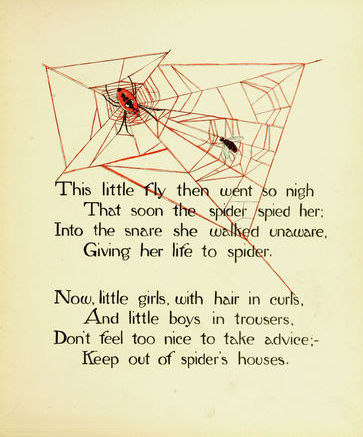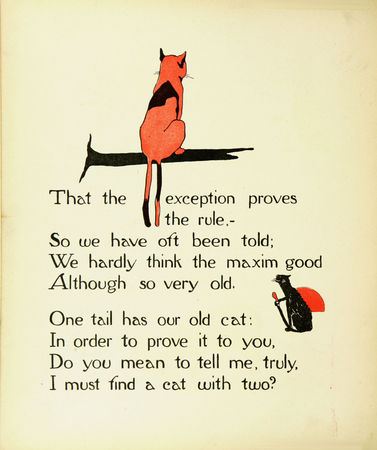As Charles Henry and Carter Wood observe, Tuesday’s Washington Post article on the fate of vintage books is another sign that the CPSIA debacle is gradually edging into the attention zone of even the more highly placed members of the press.  Florida’s St. Petersburg Times also covered the book/library angle over the weekend, following earlier coverage by the Associated Press Mar. 17, and before that by the Fort Worth Star-Telegram, the Guardian (U.K.), Cincinnati Enquirer and elsewhere. (Other aspects of the law, similarly, have won sporadic rather than sustained attention at individual large papers, and none have yet broken through to the print columns of The Deaf Lady and thereby reached those who rely on her for their news agenda.)
Florida’s St. Petersburg Times also covered the book/library angle over the weekend, following earlier coverage by the Associated Press Mar. 17, and before that by the Fort Worth Star-Telegram, the Guardian (U.K.), Cincinnati Enquirer and elsewhere. (Other aspects of the law, similarly, have won sporadic rather than sustained attention at individual large papers, and none have yet broken through to the print columns of The Deaf Lady and thereby reached those who rely on her for their news agenda.)
If nothing else, the Washington Post story should lay to rest the still sometimes heard notion that no one is talking about banning many of these books or that everyone somehow favors broadly exempting vintage books, with the only real question being how to get there. Reporter Michael Birnbaum interviewed Columbia public health specialist David Rosner, known as a high-profile lead hawk and critic of any toleration of nonzero exposure risks (and also a recurring expert witness for plaintiff’s lawyers in lead litigation, in which role he puts in a cameo in this fine 2007 Joe Nocera column in, of all places, the NYT). Rosner quite unmistakably does not want older books exempted as a general matter and does want government to intervene against those that have detectable, even if infinitesimal, levels of lead in their ink. He dismisses as ignorant — unacquainted with “the latest science” — parents and booksellers who object that they grew up with these books, they turned out okay, etc. (In fact, “latest science” or no, scientists have by no means joined in the consensus Rosner aims to suggest; hence the remarks from Centers for Disease Control spokesman Jay Dempsey the other day that “On a scale of one to 10, this is like a 0.5 level of concern“).
Birnbaum also interviews a second high-profile lead hawk, Johns Hopkins public health professor and longtime regulatory activist Ellen Silbergeld, who takes a somewhat contrasting view more akin to CDC’s (dismissing the book issue as “very clearly not a high priority” in protecting children). But that’s not all: Silbergeld appears to associate herself with (otherwise unnamed) critics who “accuse the safety commission of trying to undermine the law by stirring up popular backlash”, calling the agency’s continued inability to resolve the issue “absurd” and “disingenuous”. The suggestion here, it would seem, is that the CPSC is purposefully sabotaging the law by accommodating, even in part and inconsistently, the views of one of its own two commissioners, Thomas Moore, who famously called for some share of older books to be “sequestered” — not to mention outsiders like Rosner whose views appear to follow similar lines. So now we’re apparently meant to go on a hunt for imagined wreckers and saboteurs at the agency, presumably including its key career staff.
Meanwhile, and fortunately, discussion continues among persons who care passionately about old books for their own sake and don’t want to see them lost. Well-known author Neil Gaiman remarked on the story on Twitter (“So wrong, so wrong, so utterly, utterly wrong“) which was passed along (“retweeted”) by hundreds of his readers and fans; many blog posts and discussions resulted. David Niall Wilson (“Glimpses Into an Overactive Mind”) contributed two passionate posts (“This idiocy has to be stopped”.)  The popular James Lileks, whose eponymous site is one of the most consistently diverting in American journalism, did a short column for the Minneapolis Star-Tribune, and the subject erupted in comments at Boing Boing. Some other discussions, all worth reading: Tim & Zodi (via Deputy Headmistress), Michael Lieberman at Book Patrol (also Wessel & Lieberman), Jennifer at Series Books for Girls (“this lead thing has not gone away. Don’t think for a minute that it has”), Vivian Zabel, Le Mars, Iowa, Daily Sentinel, Aria Nadii/Wild Muse Notes.
The popular James Lileks, whose eponymous site is one of the most consistently diverting in American journalism, did a short column for the Minneapolis Star-Tribune, and the subject erupted in comments at Boing Boing. Some other discussions, all worth reading: Tim & Zodi (via Deputy Headmistress), Michael Lieberman at Book Patrol (also Wessel & Lieberman), Jennifer at Series Books for Girls (“this lead thing has not gone away. Don’t think for a minute that it has”), Vivian Zabel, Le Mars, Iowa, Daily Sentinel, Aria Nadii/Wild Muse Notes.
And don’t forget the rally next Wednesday morning, April 1, in Washington, and covered by, among other places, Apparel News. Registration can be accomplished here. And Lahle Wolfe at About.com Women in Business Blog offers six (other) ways to protest the law.
Public domain images: Yankee Mother Goose (1902), illustrator Ella S. Brison, courtesy ChildrensLibrary.org.

5 Comments
There is a statistic being thrown around about books in the children’s section of libraries being replaced every three years. (see page numbered 17 of the CPSC PDF posted yesterday.) This just sounds like a misleading statistic to me.
Xmas, I concur; I went through the children’s section of the public library here a few months ago, when all of this started, and found many books from the 1960s and some earlier.
As for whether the CPSC is over-reacting: I’m always one of the first to jump on overzealous regulatory agencies. But in this case it appears that the legislation has forced their hands, and that the CPSC has no other course of action besides the one they are taking.
Thanks, Walter, for your continued excellent coverage of CPSIA in general and the book angle in particular.
Xmas, I too am very skeptical of the CPSC figure about how often libraries replace their entire collections. My local well-funded library has MANY children’s titles from the 50s through ’85 (and a few even older), quite deliberately. Some are well-liked books that haven’t been reprinted so they keep patching the old volumes back together, some are books that get regular intermittent use (like seasonal and holiday books, or on certain less common topics for school reports), and some are ones that are simply still in good shape because they’re used by older kids or are “niche” titles with a small but passionate readership. My library’s lucky to have space for both older and newer books, but many libraries of course hang onto older titles because they don’t have the budgets to replace them, and that’s especially true in lower SES areas.
Emily Sheketoff, the president of ALA, has been quoted several times as saying the law will lead to the loss of tens of millions of titles. I suspect that’s a gross underestimate, once we take into account all the older children’s books still circulating in non-library venues, like in the homes of kids, in classrooms, in waiting rooms, etc. According to the American Association of Publishers, in 2007, there were 3.4 BILLION children’s books printed. Now that big number includes some titles for kids in the 12-16 range, and it reflects growth in children’s publishing. So let’s be conservative and say that only 1% of that number are still around for each of the years 1980 through 1984. That would still be 170 million books just for that five year stretch – and given that I can readily find inexpensive copies of children’s books published even in the first couple decades of the 20th century, I think it’s fair to say there are hundreds of millions more pre-1980 children’s books still in use in one fashion or another.
Every single obscure vintage children’s title I’ve tried to locate online in the past five years, I’ve found INSTANTLY. I’ve literally never looked for one I couldn’t find on amazon, usually for under $20 which is what many new titles cost. There’s never been a book that I couldn’t find with at least 2 copies available – and those were books that had tiny print runs and were never re-released. Then think about all the old books not for sale – sitting on people’s shelves or boxed up to save for the grandkids – or for sale at yard sales, rummage sales, thrift stores. It’s staggering.
Books, even those for very young children, survive.
So what will happen if we take away all those old books? No one knows, but I feel certain it will not be good for the literacy efforts in this country.
Is the color Sunday comics section of your local newspaper legal under CPSIA?
Mark B, About 12 years ago when one of our children was a crawler there was a fuss going on about lead in magazine ink. Don’t let your kids chew on magazines and colored newsprint is how the warning went. Don’t know if that was new-parent-rumor-mill or not.